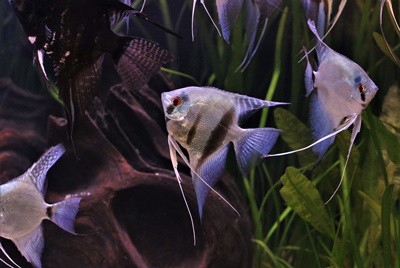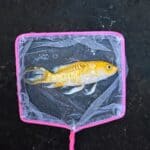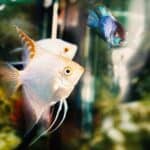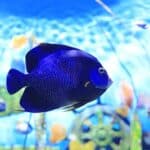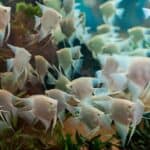Introducing a new angelfish to an aquarium can be difficult because they can become hostile and aggressive. Also, angelfish can get bullied if housed with incompatible tank mates.
Fish may refuse to eat, die from shock, or seclude themselves from others.
When you bring an angelfish home, place it in a quarantine tank. Float the bag in the tank for 20 minutes, then open it and add the tank water to it, one cup at a time.
Do this over 30 minutes until it’s full before releasing the fish. You can prepare the main tank for the fish by dimming the lights and feeding all the fish.
If your angels are territorial, rearrange their decorations to disrupt boundaries.
Ensure that the fish in the tank are already suitable tank mates for angelfish. Certain fish, like Oscars, will attack angelfish. Likewise, angelfish may eat small fish like guppies.
Introducing New Angelfish
Introducing new angelfish to a populated tank should be approached with caution. Angelfish are known for being aggressive and bullying other fish.
Adding new angelfish to an existing angelfish group can cause issues since:
- The existing fish have a social hierarchy, which the new fish doesn’t yet understand.
- There are territories and boundaries, leaving no room for new fish.
- Mates are already chosen, leaving the new fish as the odd one.
- Baby fish and fry could be hatching and growing, making the parents hostile toward newcomers.
This can result in fights, leading to injury and death. According to Behaviour Brill, angelfish react to environmental stimuli and adjust their behavior. Adding new fish to the tank will trigger new behaviors.
Dominant fish can be more aggressive, picking on the new member. Shier fish or new fish may hide for up to a week until they feel comfortable in their new home.
Adding New Fish To An Established Tank
Avoiding fights and bullying involves taking specific steps before adding the fish. Here’s how to proceed:
Check for Fry
Before anything else, ensure that no current angelfish are spawning or caring for fry. During this time, the parent fish will be more territorial and aggressive to others.
Break Up Territories
You can also move a few items around in the tank to disrupt established territories. This doesn’t always work, but it can distract the fish. Ensure there are shelters for new fish to retreat to as they acclimate.
Add New Decorations
Adding plants is always a good idea, especially for angelfish. These creatures enjoy plant life to hide behind and nibble on. Not only will this give a new angelfish a new hiding place. It provides the existing angelfish a curious new object to investigate. This will take their attention off the newcomer.
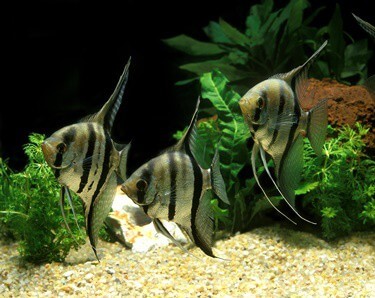
Quarantine New Angelfish
Quarantine new fish before adding them to a tank with an existing population.
It’s okay for a quarantine tank to be smaller than the ideal tank size for the fish. The fish will only live here for 2-3 weeks. It shouldn’t be overly small, but a few gallons less than ideal will be fine. You can reference the tank you saw at the aquarium shop.
A quarantine tank can be fully or partially filled using water from your existing tank. This has the benefit of introducing established bacteria into the tank. However, this tank should still be allowed to cycle for 2 weeks before adding any fish. You will need:
- A heater.
- Light.
- Filter.
- Possibly an air pump if there isn’t enough surface agitation.
- Sponge filters are a great 2-in-1 solution.
You can include an ornament or fake plant for the fish to hide behind for comfort. This will help minimize stress.
Introduce Slowly
After quarantine, avoid placing the fish directly in the tank. If there are conflicts, this could physically damage the new fish right away.
Instead, place the newcomer in a fry basket or a clear container. This can then be placed in the tank. The new and old fish can now investigate each other without the risk of harm.
Feed The Existing Fish And Dim The Lights
After 15-20 minutes, feed all of the fish as usual. You should then dim the lights or turn them off completely. Gently release the new fish into the tank and watch for problematic behavior. Should any overly aggressive behavior arise and not subside within 30 minutes, consider separating the fish for safety’s sake.
The fish must acclimate to the new tank’s water temperature and chemistry. This minimizes the potential for the fish to go into shock.
Not allowing a fish to acclimate to water gradually can cause shock, which may lead to death.
Give The Fish Time
If there is conflict and you’ve separated the fish, wait 30 minutes to 1 hour and try again. Leave the new fish in the fry basket or container for as long as possible.
You can wait for the fish to calm down if mild aggression occurs. If the aggression increases, you’ll see this when fish run into walls or decorations. Remove the new fish and wait again.
If no conflict arises, leave the new fish here for one day. You can then release it into the tank if no fights break out. Keep an eye on the fish in the coming hours. The existing fish may be well-fed and distracted enough by the new decorations and lighting, so they don’t bother the newcomer.
Can I Skip Quarantining New Fish?
Quarantining new fish is very necessary. While you can technically skip this step, it may result in the new fish getting sick or infecting your tank with an illness. You won’t know this until it’s too late. It’s better not to risk it.
Wild-caught and farmed fish are exposed to many different organisms before you bring them home. For example, The Journal of Fish Diseases found that a single freshwater angelfish breeder population had a widespread outbreak of iridovirus. That resulted in many deaths.
Some aquarium shops will quarantine new arrivals before putting them up for sale. However, this isn’t always the case. Quarantining fish allows any illnesses, infections, or parasites to make themselves known before they can contaminate the main tank.
It is much easier to treat such problems in a small quarantine tank than in a large one. Quarantining preserves the health of your current fish and protects weaker fish from being harassed.
Additionally, quarantining allows the new angelfish to acclimate to its new environment with minimal stress. That’s especially true if you included water from your existing tank.
Introducing Smaller Angelfish
Is it a good idea to group small angelfish with big angelfish? Or will it merely result in a gory catastrophe in your beautiful aquarium?
Angelfish tend to be more aggressive towards other adult angelfish. Smaller angelfish may be lightly harassed initially, but they tend to be ignored shortly after that. That is unless paired couples are spawning. Such times will see heightened levels of aggression and territorial behavior.
Angelfish are of the cichlid family, so they’ll exhibit predatory behavior when housed with smaller fish. They are not known for being cannibals unless stressed or very hungry. Juvenile angelfish may be lightly bullied, but this should fade not long after the fish are introduced.
Small Angelfish With Big Angelfish
Introducing smaller angelfish to a tank is best done in small groups of 3 or more. It limits the amount of harassment bigger fish will exhibit. After all, they can’t single a lone fish out. Animal Cognition found that juvenile fish would shoal with similar fish in a new environment.
As such, the fish will initially shoal together before eventually joining the existing shoal of larger angelfish.
Follow the same procedure outlined above for introducing new, smaller angelfish to a tank. Female angelfish tend to be accepted to the school quicker than males.
Consider only working with females if you have a very aggressive tank.
Adding Angelfish To A Community Tank
In some instances, angelfish makes a great addition to community tanks. Take careful note of ‘in certain cases.’ Angelfish are predatory fish that live on omnivorous diets. In captivity, they don’t need to hunt for food. Housing angelfish with small fish, like small tetra or guppies, will still trigger hunting instincts.
You must always be careful when curating community tanks, especially with diverse species. Larger fish, like Oscars and African Cichlids, can turn on and attack angelfish. Certain fish species can also be fin nippers.
They will only be compatible with larger tanks that allow for personal space. Given this, many angelfish keepers will create angelfish-only tanks.
There are many compatible tank mates for angelfish, including:
- Corydoras catfish.
- Silver dollars.
- Pleco catfish.
- Mollies.
- Dwarf gouramis.
- Swordtails.
- Rainbowfish.
- Large tetra species.
- Blue rams.
When populating a community tank, it’s wise to introduce new fish by adding them all together. This prevents any fish from staking out territory and becoming aggressive.
Angelfish Community Tank Setup
Community tanks are usually more work but certainly worth the effort. Finding the balance between the needs of each species can be tricky. Thankfully, there is plenty of information available for angelfish community tanks.
Choose The Right Size
Ensure the tank is large enough for the number of fish in it. A standard-sized tank for a pair of angelfish is 30-40 gallons. After all, these fish need a lot of space. If you want to keep a small school of angelfish, upgrade to a 55-gallon or larger tank.
The tank size and setup will also depend on what other fish you want to keep in the tank.
- Catfish and bottom feeders will happily coexist in a 30-55 gallon tank.
- Fish that dwell at the mid-level or near the surface (like gouramis) need a bigger tank.
- If other fish dwell at the same level as angelfish and are similar in size, add another 10 gallons to your minimum tank size.
- For a school of 3-5 angelfish and 6-7 additional tank mates, a 55-gallon tank will usually suffice.
Always add plants and ornaments in such a tank to act as buffers for fish seeking shelter.
Minimum Number Of Angelfish
In big enough tanks, angelfish thrive in large groups. You’ll see natural schooling behavior arise in groups of 5 or more. This is desirable for many, as angelfish weave and gracefully glide through the water. Shoaling behavior makes these movements even more pronounced.
Angelfish can live in big groups if the tank is large enough to accommodate them. Remember that the more crowded the tank, the more frequently maintenance is needed. A group of 3-5 is ideal.
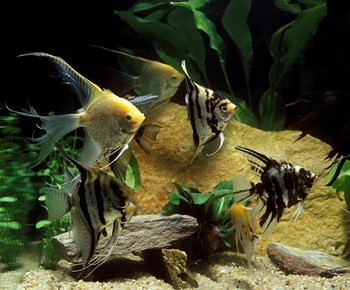
Can Two Male Angelfish Live Together?
Male angelfish can live together. However, this greatly depends on the size of the tank. The two males may become defensive of their territory if they feel crowded.
This will encourage them to fight and kill other males. You can always get a 55-gallon tank for the pair to avoid severe fighting.
Angelfish usually get aggressive toward one another when spawning or protecting fry. A single-sex angelfish population may be more ideal for some people. You won’t have mating to worry about, which will cause fewer conflicts.
With that said, angelfish are tricky to sex before they are fully grown. If you have two males and one female, this may cause more fighting. That makes it wise to keep 2 angelfish at a time or larger groups of 4-5. This will help balance out the sexes.
Consider using distractions if you have a tank with many males. You could invest in a larger tank with more decorations. This will give the fish better things to pay attention to and plenty of space to carve out their territory.
Are Angelfish Hardy?
Angelfish are considered hardier fish. They can tolerate a wide variety of tank parameters. However, these parameters must still exist within an acceptable range of their ideal tank setup.
Likewise, angelfish still need careful and consistent care. You should never suddenly introduce new angelfish to a tank. Hardy as they are, angelfish are susceptible to shock if moved from the store bag into the tank. This is why an acclimation process is so important. The fish needs to adjust to a difference in:
- Temperature
- Water hardness
- Acidity
When kept in perfect conditions and fed a proper diet, angelfish can live up to 10 years. If you apply care and attention for just a few weeks in the beginning, you can have pets for a decade.
New Angelfish Stays In Corner
You may notice that your new angelfish seems shy. It may hide in the corner or isolate itself from other fish. Although they’re not overly energetic, angelfish aren’t prone to hiding without a cause. After a settling-in period, most angelfish will move throughout the tank. You should observe the fish.
- Does it make any attempt to emerge from hiding?
- Are other fish harassing it?
- Is it refusing to eat?
- Does it have any injuries or noticeable signs of infection or the like?
If the answer is “yes” to these questions, record the symptoms and seek the appropriate treatment. If the fish is being bullied, the tank may be overpopulated.
Why Is My New Angelfish Hiding?
Angelfish hide when feeling unwell, not only due to illness or disease.
Bad Water Conditions
Even though angelfish are hardy, incorrect tank parameters will still impact their well-being. For example, too-cold water will slow their metabolism and system down. This can make them sluggish and constipated, inspiring the angelfish to hide. Check the parameters of the tank.
- Is it set to the correct temperature, pH, and hardness?
- Is the filter’s output too strong?
If you make adjustments, you should see the angelfish becoming more active.
Too Much Light
Angelfish can also hide when stressed. For example, over-exposure to light can be stressful. Keep the tank’s light on for 6-8 hours each day.
Nowhere To Properly Hide
An angelfish may also hide in the corner when there aren’t enough plants or objects in the tank to shelter behind. Remember that a new fish is going through a very stressful time. Try to accommodate it by giving it a place to rest.
If you introduce new angelfish slowly and carefully, they should join the group without issue.

